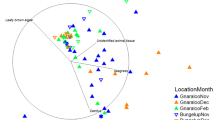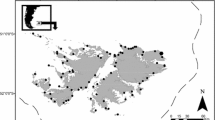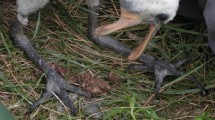Abstract
The diet and breeding ecology of Yellow-legged Gulls (Larus michahellis atlantis) were studied on Selvagem Grande, North Atlantic in the nesting season of 2007. We collected and analyzed 715 pellets from adults. The most frequent prey were White-faced Storm-petrels (Pelagodroma marina; present on 40.8% of all pellets) and the endemic land snails (Theba macandrewiana; present on 36.5% of all pellets). Other birds, namely Cory’s Shearwaters (Calonectris diomedea), Macaronesian Shearwaters (Puffinus assimilis), Bulwer’s Petrels (Bulweria bulwerii), and Band-rumped Storm-petrels (Oceanodroma castro) were relatively less frequent, but overall, seabirds were present in ca. 50% of all pellets, representing an estimated 60.4% of all mass consumed by gulls. We estimate that the contribution of seabirds to the overall caloric balance accounted for 82.5% of all energy consumed. The number of gull pairs breeding on Selvagem Grande was 12 on 2005 and 2007. Breeding success was low (0.92 and 0.25 juveniles per breeding pair, respectively). Using a simple bioenergetics model, we estimate the breeding gull population to have the potential to consume approximately 4,847 adult/sub-adult seabirds in 3.5 months in order to meet its energetic requirements. The importance of the estimated predation levels is discussed and some management actions are suggested.
Similar content being viewed by others
References
Barrett RT, Camphuysen K, Anker-Nilssen T, Chardine JW, Furness RW, Garthe S, Hüppop O, Leopold MF, Montevecchi WA, Veit RR (2007) Diet studies of seabirds: a review and recommendations. ICES J Mar Sci 64:1675–1691
Belant JL, Seamans TW, Gabrey SW, Ickes SK (1993) Importance of landfills to nesting herring gulls. Condor 95:817–830
Birt-Friesen VL, Montevecchi WA, Cairns DK, Macko SA (1989) Activity-specific metabolic rates of free-living Northern Gannets and other seabirds. Ecology 70:357–367
Bosch M, Oro D, Cantos FJ, Zabala M (2000) Short-term effects of culling on the ecology and population dynamics of the yellow-legged gull. J Appl Ecol 37:369–385
Campos A, Granadeiro JP (1999) Breeding biology of the White-faced Storm-Petrel on Selvagem Grande, North-East Atlantic. Waterbirds 22(2):199–206
Carey C, Rahn H, Paris P (1980) Calories, water, lipid and yolk in avian eggs. Condor 82:335–343
Cramp S, Simmons KEL (1983) The birds of the Western Palearctic, vol 3. Oxford University Press, Oxford
Costa LT, Nunes M, Geraldes P, Costa H (2003) Zonas importantes para as Aves em Portugal. SPEA, Lisboa
Cramp S (1988) The birds of the Western Palearctic, vol 5. Oxford University Press, Oxford
Den Hartog JC, Nørrevang A, Zino PA (1984) Bird observations in the Selvagens Islands (21-23 October 1978 and 27 May-7 June 1981). Bol Mus Mun Funchal 36(160):111–141
Drent RH, Klaassen M, Zwaan B (1992) Predictive growth budgets in terns and gulls. Ardea 80:5–17
Duhem C, Roche P, Vidal E, Tatoni T (2008) Effects of anthropogenic food resources on yellow-legged gull colony size on Mediterranean islands. Pop Ecol 50:91–100
Equipa Atlas (2008) Atlas das aves nidificantes em Portugal (1999-2005). Assírio & Alvim, Lisboa
Furness RW, Ensor K, Hudson AV (1992) The use of fishery discards by gull populations around the British Isles. Ardea 80:105–113
González-Solís J, Oro D, Pedrocchi V, Jover L, Ruiz X (1997) Bias associated with diet samples in Audouin’s Gulls. Condor 99:773–779
Granadeiro JP, Dias MP, Rebelo R, Santos CD, Catry P (2006) Numbers and population trends of Cory’s Shearwater Calonectris diomedea at Selvagem Grande, northeast Atlantic. Waterbirds 29:56–60
Guillemette M, Brousseau P (2001) Does culling predatory gulls enhance the productivity of breeding common terns? J Appl Ecol 38:1–8
Harris MP (1970) Rates and causes of increases of some British Gull populations. Bird Study 17:325–335
Hilton GM, Furness RW, Houston DC (2000) A comparative study of digestion in North Atlantic seabirds. J Avian Biol 31:36–46
Hoyt DF (1979) Practical methods of estimating volume and fresh weight of birds’ eggs. Auk 96:73–77
Ickes SK, Belant JL, Dolbeer RA (1998) Nest disturbance techniques to control nesting by gulls. Wildl Soc Bull 26:269–273
Jensen A (1981) Ornithological winter observations on Selvagem Grande. Bocagiana 62:1–7
Jouanin C (1974) Note sur Larus argentatus atlantis aux îles Selvagens. Cyanopica 1(4):19–24
Jouanin C, Roux F (1964) Une mission aux îles Salvages. Sci Nat Paris 61:1–8
Jouanin C, Roux F (1965) Contribution à l’Étude de la Biologie de Pelagodroma marina hypoleuca (Webb, Berthelot et Moquin-Tandon). Bol Mus Mun Funchal 19(77):16–30
Konecny MJ (1987) Food habits and energetics of feral house cats in the Galápagos Islands. Oikos 50:24–32
Lindsay MCM, Meathrel CE (2008) Where, when and how? Limitations of the techniques used to examine dietary preference of Pacific Gulls (Larus pacificus) using non-consumed parts of prey and regurgitated pellets of prey remains. Waterbirds 31:611–619
Lockley RM (1952) Notes on the birds of the islands of the Berlengas (Portugal), the Desertas and Baixo (Madeira) and the Salvages. Ibis 94:144–157
Matias R, Catry P (2008) The diet of feral cats at New Island, Falkland Islands, and impact on breeding seabirds. Polar Biol 31:609–616
Moniz P, Monteiro L, Oliveira P (1997) The Little Shearwater. In: Hagmeijer W, Blair M (eds) The EBCC Atlas of European breeding birds. T & AD Poyser, London
Moore CC (1988) Brief notes on birds seen in and around Selvagem Grande, August 17-18th, 1987. Bocagiana 121:1–5
Morais L, Santos C, Vicente L (1998) Population increase of Yellow-legged Gulls Larus cachinnans breeding on Berlenga Island (Portugal), 1974-1994. Sula 12:27–37
Morse DH, Buchheister CW (1977) Age and survival of breeding Leach's storm-petrels in Maine. Bird-Band 48:341–349
Mougin JL, Stahl J-C (1981) Le régime alimentaire des Goélands argentés Larus argentatus atlantis de’île Selvagem Grande. Cyanopica 2(3):43–48
Nagy KA, Girard IA, Brown TK (1999) Energetics of free-ranging mammals, reptiles, and birds. Annu Rev Nutr 19:247–77
Nunes M, Vicente L (1998) Breeding cycle and nestling growth of Bulwer's Petrel on the Desertas Islands, Portugal. Col Waterbirds 21(2):198–204
Ogilvie Grant WR (1896) On the birds observed at the Salvage Islands near Madeira. Ibis 7(2):41–55
Oro D, de León A, Minguez E, Furness RW (2005) Estimating predation on breeding European storm-petrels (Hydrobates pelagicus) by yellow-legged gulls (Larus michahellis). J Zool, Lond 265:421–429
Oro D, Bosch M, Ruiz X (1995) Effects of a trawling moratorium on the breeding success of the yellow-legged gull Larus cachinnans. Ibis 137:547–549
Oro D, Martínez-Abraín A (2007) Deconstructing myths on large gulls and their impact on threatened sympatric waterbirds. Anim Conserv 10:117–126
Phillips RA, Thompson DR, Hamer KC (1999) The impact of great skua predation on seabird populations at St Kilda: a bioenergetics model. J Appl Ecol 36:218–232
Piersma T (2002) Energetic bottlenecks and other design constraints in avian annual cycles. Integr Comp Biol 42:51–67
Robel RJ, Press BM, Henning BL, Johnson KW, Blocker HW, Kemp KE (1995) Nutrient and energetic characteristics of sweepnet-collected invertebrates. J Field Orn 66:44–53
Robertson HA, James PC (1988) Morphology and egg measurements of seabirds breeding on Great Salvage Island, North Atlantic. Bull BOC 108(2):79–87
Rodríguez B, de León L, Martín A, Alonso J, Nogales M (2003) Status and distribution of breeding seabirds in the northern islets of Lanzarote, Canary Islands. Atl Seabirds 5(2):41–56
Schmitz E (1893) Die Puffinenjagd auf den Selvagens-Inseln im Jahre 1892. Orn Jahrb 4:141–147
Spaans AL (1971) On the feeding ecology of the Herring Gull Larus argentatus Pont. in the northern part of the Netherlands. Ardea 59:73–188
Stenhouse IJ, Montevecchi WA (1999) Indirect effects of the availability of capelin and fishery discards: gull predation on breeding storm petrels. Mar Ecol Prog Ser 184:303–307
Stiven AE (1961) Food energy available for and required by the Blue Grouse chick. Ecology 42:547–553
Swennen C (1989) Gull predation upon eider Somateria mollissima ducklings: destruction or elimination of the unfit? Ardea 77:21–44
Van Klinken A (1992) The impact of additional food provisioning on chick growth and breeding output in the Herring Gull Larus argentatus: a pilot experiment. Ardea 80:151–155
Vidal E, Medail F, Tatoni T (1998) Is the yellow-legged gull a superabundant bird species in the Mediterranean? Impact on fauna and flora, conservation measures and research priorities. Biodivers Conserv 7:1013–1026
Votier SC, Bearhop S, Ratcliffe N, Phillips RA, Furness RW (2001) Pellets as indicators of diet in Great Skuas Catharacta skua. Bird Study 48:373–376
Votier SC, Bearhop S, Ratcliffe N, Phillips RA, Furness RW (2004) Predation by great skuas at a large Shetland seabird colony. J Appl Ecol 41:1117–1128
Zino PA (1971) The breeding of Cory’s Shearwater Calonectris diomedea on the Salvage Islands. Ibis 113:212–217
Acknowledgments
This paper is an output of the project PDCT/MAR/58778/2004, financed by Fundação para a Ciência e a Tecnologia (FCT-Portugal) and Fundo Europeu de Desenvolvimento Regional (FEDER). Further support was received through Programa Plurianual (UI&D 331/94). Thanks are due to the Parque Natural da Madeira, namely Paulo Oliveira and Dília Menezes, for permissions to carry out the work and for important logistical support. The wardens João Jaques da Mata and Gil Pereira provided invaluable information and field assistance. The wardens Lourenço and Nélio obtained information on the number of gulls present on Selvagem Pequena and Ilhéu de Fora. Rui Rebelo provided data on the mass of land snails. Pierre Beaubrun and Jean-Marc Pons kindly provided unpublished data on the body mass of Atlantic Yellow-legged Gulls. This manuscript benefited from detailed comments from José Pedro Granadeiro and two anonymous referees. This study complies with the current laws concerning wildlife research in Portugal.
Author information
Authors and Affiliations
Corresponding author
Additional information
Communicated by C. Gortázar
Rights and permissions
About this article
Cite this article
Matias, R., Catry, P. The diet of Atlantic Yellow-legged Gulls (Larus michahellis atlantis) at an oceanic seabird colony: estimating predatory impact upon breeding petrels. Eur J Wildl Res 56, 861–869 (2010). https://doi.org/10.1007/s10344-010-0384-y
Received:
Revised:
Accepted:
Published:
Issue Date:
DOI: https://doi.org/10.1007/s10344-010-0384-y




